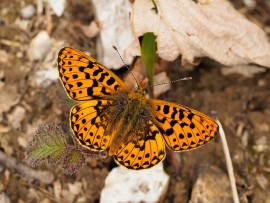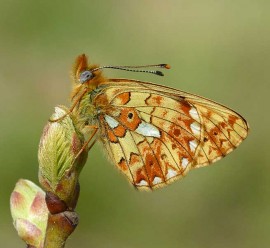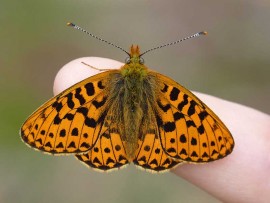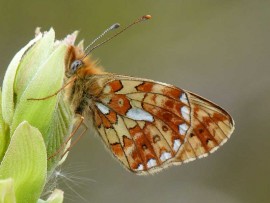by Martin Kalaher
The earliest of our fritillaries to emerge each spring this species was once known as the "Woodsman's Friend", a name which was entirely apt as this once very common butterfly regularly followed the forester in his "coppice rotation". Sadly, it is no longer a common butterfly in our woodlands, having fallen into precipitous decline, both locally and nationally. When we try and understand why a butterfly species is doing so badly, it makes sense to consider the larval food plant to see if that provides a clue. Unsurprisingly it does, for the caterpillars are very fussy eaters, requiring violet seedlings/one-year old plants to assuage their appetite. Seedlings and young plants require bare/disturbed soil, located in a sunny aspect, and therein lies the problems.
Once widespread and abundant this species was found in just 62 tetrads in the 1990-1994 county survey, with a further calamitous decline twenty years later when it occupied just 20 tetrads in the 2010-2014 survey. It has been reduced to two strongholds, Rewell Wood in West Sussex and Abbot's Wood in East Sussex. What has caused this precipitous decline? There are three main reasons and they all revolve around major changes in woodland management. Traditional coppicing had been gradually declining for many decades prior to the Second World War but it was the widespread switch to non-native conifer plantations in the 1950s onwards that changed things so dramatically. Ironically, in the early years of a young conifer plantation both Common-dog Violets and in turn, Pearl-bordered Fritillaries are likely to do very well. Unfortunately, within a few years the serried ranks of conifers cut out all light and nothing much can grow on the woodland floor, including violets. With the main harvest not due for 60+ years there is no prospect of a colony surviving. The third main reason revolves around market forces. In the 1990s and the early part of new millennium wood imports were so cheap that it just wasn't worthwhile for the private estates to harvest their wood. As a senior forester once said to me, "Except for Douglas Fir and Oak, the rest will only sell for firewood and since felling the trees isn't commercially viable it is better to do nothing and wait for an upturn in the market place".
In this county the Pearl-bordered Fritillary is on the wing from mid/late April to early June. The average flight period for the 2010-2014 atlas was 21 April to 1 June. Emergence was approximately two weeks earlier compared to the survey findings in the period 1990-1994. On warm sunny days the males are very active as they flit and glide across their breeding sites looking for virgin females. Having mated the females hide for a day or so, waiting for their eggs to ripen and then embark on short forays looking for suitable violets. They choose small, young plants on warm, bare ground and rock, and also plants that surface-through a warm, dry leaf litter. The eggs hatch about two weeks later and the caterpillar immediately feeds on violet seedlings. It completes its fourth moult by September and then settles down for the rest of the autumn and winter, curled up in a twisted dead leaf. It usually re-appears in early March and resumes feeding on violets, but after the fifth moult it ceases to feed and forms a chrysalis, which is suspended in a nest of withered vegetation, just above the ground. The adult butterfly emerges about three weeks later.
It is a medium-size fritillary with blocks of black spots distributed over its orange-brown uppersides. With closed wings the hind wing is very distinctive with seven silvery white pearls on the outer edge, and two bright patches of silver situated on either side of a central pentagonal cell that contains a black dot. Small Pearl-bordered Fritillaries also have seven silvery white pearls on the border of the hindwing but have seven or eight patches of silver surrounding the "pentagonal cell", which contains a considerably larger black dot.
Without a sustained effort by many parties we are likely to lose this butterfly species in this county. There is an on-going effort to prevent this from happening and this began with the re-introduction of this species to Abbot’s Wood, East Sussex in 2004. Stuart Sutton of the Forestry Commission and Mike Mullis, a highly experienced breeder of butterflies, were successful in re-instating a strong, self-sustaining colony, which persists to this day. Also in recent years, Butterfly Conservation and various partners, including the Forestry Commission, the South Downs National Park, the Norfolk Estate and several other private landowners have strived to try and prevent the further decline of this species. As part of this very focussed initiative a project called "Fritillaries for the Future" was launched by Butterfly Conservation in 2015 (and ably supported by the Heritage Lottery Fund). This is a species that needs all the help it can get!
Neil Hulme has been very involved with this species and for further reading and enlightenment I would encourage members to read his chapter on the Pearl-bordered Fritillary in "The Butterflies of Sussex".
The best sites to see this species are: Rewell Wood SU984077 to SU980079 and Abbot's Wood TQ5608, currently TQ561081 and TQ569082.






